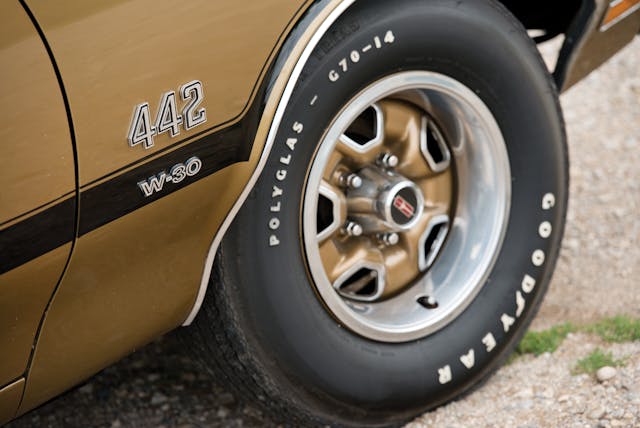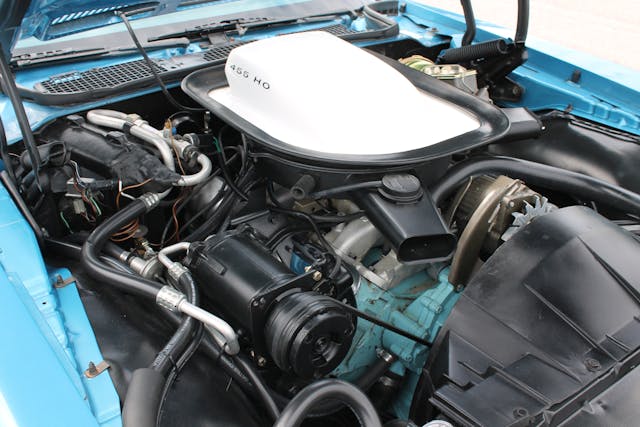Displacement unleashed: 1970 brought several flavors of GM 455
In 1970, when General Motors rescinded its edict that limited mid-size cars to 400 cubic inches, it was like uncaging a predator that sat and watched from afar as cross-town rivals offered 7.0-liter behemoths. GM had done well with what it had, but now the corporation could exploit high-performance in more competitive terms.
Interestingly, Oldsmobile, Buick, and Pontiac all marketed 455s starting in 1970, and they were engineered from different philosophies and had different trajectories through the decade. How did they compare? Rick O. Rittenberg’s America Performance V-8 Specs: 1963–1974 (full disclosure: yours truly wrote the foreword) helps us note statistical differences:
Oldsmobile 455: It’s all in the cam
Oldsmobile (along with Cadillac) was the first, in 1949, to seize upon the idea of high-compression V-8s. This first series of Rocket V-8s lasted through 1964, topping out at 394 cubic inches; the second generation of the big Rocket continued in 1965 at 400 and 425 cubic inches, with the latter receiving a 0.275-inch boost in stroke in 1968 to become the Rocket 455. At the time, Oldsmobile only offered the 455 for full-size cars and Toronados, with the latter’s W34 package topping the range with 400 horsepower and 500 lb-ft. This engine included a scoop similar to those nifty under-the-bumper scoops on top-performance mid-size models.

Though General Motors had that pesky edict, Hurst helped bypass this rule by producing 515 examples of the 4-4-2-based Hurst/Olds, all with a 390-horse 455 with 10.50:1 compression. (It was later revealed that Olds flouted the rule and actually installed the 455 on the assembly line.) Of course, Oldsmobile released the hounds for 1970 and offered the standard 455 for the 4-4-2 plus a W30 package with 370 horses. Unlike previous W30s, which were cammed out of sight—as Oldsmobile expected owners to add headers and other mild mods to wake up the engine some more—Olds gave the automatic W30 a slightly milder cam that was more streetable. This was typical of Olds at the time, which had played around with cams for several years with the 400-powered 1968–69 4-4-2 automatic (with 25 fewer horses from than the stick) and the automatic-only 1969 4-4-2 W32, which was billed as a W-Machine “a mother could learn to love.”

Additionally, a new SX package for the Cutlass Supreme came standard with the 320-horse 455 two-barrel, then was replaced in February 1970 by the 365-horse 455 (10.25:1 compression) from the big cars; optional was the 365-horse W32 455 (10.50:1 compression) that was identical to the standard engine for the 4-4-2. Horsepower dropped in 1971 due to lowered compression and, aside from the W30’s swan song for 1972, an emasculated 455 lasted through 1976.
Buick 455: A tale of torque
Kids growing up in the 1960s–70s knew how fast Buicks could be thanks to riding along in Mom and Dad’s car as it easily powered away from stoplights. This was Buick’s modus operandi, as its engineers designed its engines for solid low-end torque. “Fast for the street,” Buick engine development engineer Denny Manner told us recently, at Buick GS Nationals. “That was our goal. Buicks were heavy, loaded with power everything. That’s how people bought ’em. Low-end torque was key because that’s how people perceive performance.” There was little interest in modifications. As such, the oversquare 455 (unique among the three brands here) in Stage 1 tune featured peak torque at a low rpm—2800 in 1970. Compare that with 3600 for the W30.

This 455’s genesis can be found in the 1967 model year when Buick replaced the “Nailhead” V-8 that had powered most Flint flyers since 1953. The new big-blocks measured 400 and 430 cubic inches, with the 360-hp 430 being reserved for full-size cars and the Riviera through 1969. Both engines produced peak torque at 3200 RPM (on the high side for Buick) but, when Buick added an extra 0.125-inch to the bore for 1970 to create the 455, 510 lb-ft of torque was available at 400 rpm less. This was true for all the 455s, from the 350-horse engine, standard on the GS 455, to the 370-horse engine available for big cars and the Riviera (though truth be told, the latter two were more or less identical in practice). Thanks to thin-wall casting, the 455 also weighed less than similar engines from General Motors.
The Stage 1 managed to live on through 1974, and the 455 maintained Buick’s trademark for low-end torque through 1976.
Pontiac 455: Using their heads
In contrast to Oldsmobile and Buick, Pontiac took a different path with the 455, both for 1970 and beyond. The GTO’s 455 was competitively rated at 360 horsepower, though it was not as powerful as its 400 Ram Air III and IV siblings, nor was it as fast as the W30 and Stage 1 from Oldsmobile and Buick, respectively. Why did Pontiac not go all-out like its corporate cousins?
Per Mike Noun in the January 2021 issue of Pontiac-Oakland Club International’s Smoke Signals, there was a corporate shake-up in February 1969 when John DeLorean was promoted to General Manager of Chevrolet. DeLorean was replaced by James McDonald, a gentleman known more for being a bean counter than an automotive enthusiast. McDonald demanded a review of upcoming 1970 model year equipment, and it seems he dropped the hammer on “pet projects started by his predecessor that he deemed unnecessary or counter-productive towards maximizing sales.” That meant the Ram Air V project was discontinued, leaving the upcoming 455 with little development and the carry-over Ram Air IV as the top engine.
Aside from the GTO, the 455 was only available for full-size models. A 360hp version came with 10.0:1 compression, while the 370-horse option, installed in the GTO and Grand Prix, used 10.25:1 compression. Why the all-new 1970 Firebird—introduced mid-year due to a strike—didn’t receive the 455 is another head-scratcher.

All that and more changed for 1971. While compression was lowered, the 455 was improved in ways that should have been done for 1970. In particular, Pontiac added the Ram Air IV’s round-port heads to create the 455 HO. Round-port heads first made their appearance mid-year in 1968 with the Ram Air II, and Pontiac marginally improved them in 1969 and again in ’71 with the 455 HO. Rated at 335 horsepower, it was actually faster than the previous year’s 455. The HO was available for all two-door A-bodies, plus the Firebird Formula and Trans Am. The “regular” 455 continued to be available, now at 325 horses, with both 455s continuing through 1972 with few changes.
Those round-port heads were key in the development of the 1973 Super Duty 455, which replaced the 455 HO. On paper it was rated at 310 horsepower, but what was actually emissions-certified put out 20 horses less (and for 1974 the SD 455 was properly rated at 290). For both years, the SD 455 was only available for the two performance Firebird models, though it was planned to be offered on A-bodies too. After 1974, round-port 455s were no more; the 455 soldiered on through 1976.
Although starting the decade off weak, Pontiac is to be commended for making the Dark Ages a little brighter through 1974.


